Introduction to International Affairs: Poverty Analysis and Solutions
VerifiedAdded on 2023/01/11
|5
|936
|44
Homework Assignment
AI Summary
This assignment, prepared for INS-3003 Introduction to International Affairs, delves into the complex issue of poverty. The student critically examines whether poverty stems from laziness, lack of ambition, or skills deficits, and explores poverty as a global phenomenon, providing relevant statistics. The assignment emphasizes the importance of poverty reduction, comparing need-based and asset-based development strategies. The student also considers the most impactful use of a single dollar to combat poverty and reflects on the challenges of living on a minimal daily budget. The assignment concludes with a list of references, offering further insights into the subject.
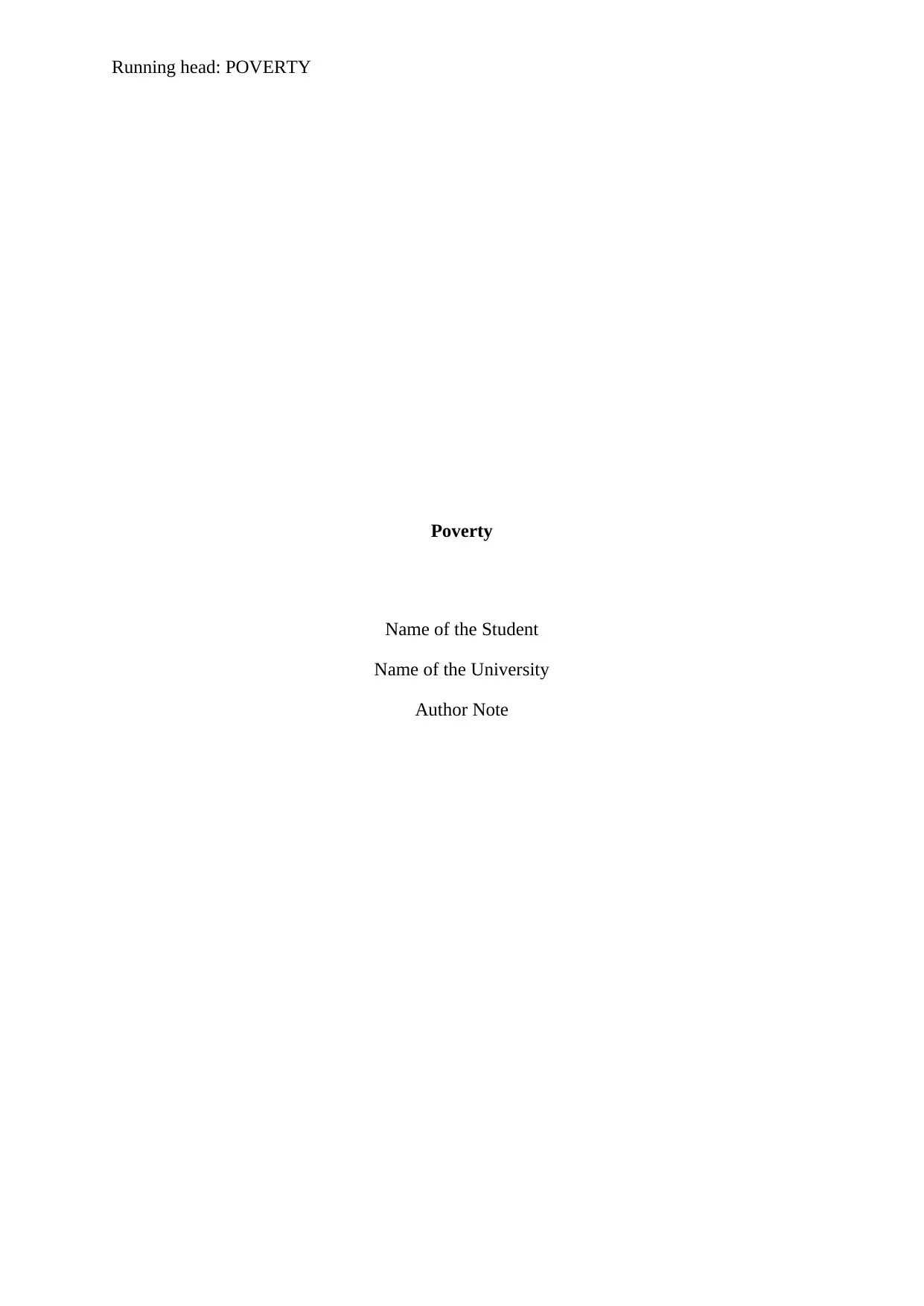
Running head: POVERTY
Poverty
Name of the Student
Name of the University
Author Note
Poverty
Name of the Student
Name of the University
Author Note
Paraphrase This Document
Need a fresh take? Get an instant paraphrase of this document with our AI Paraphraser
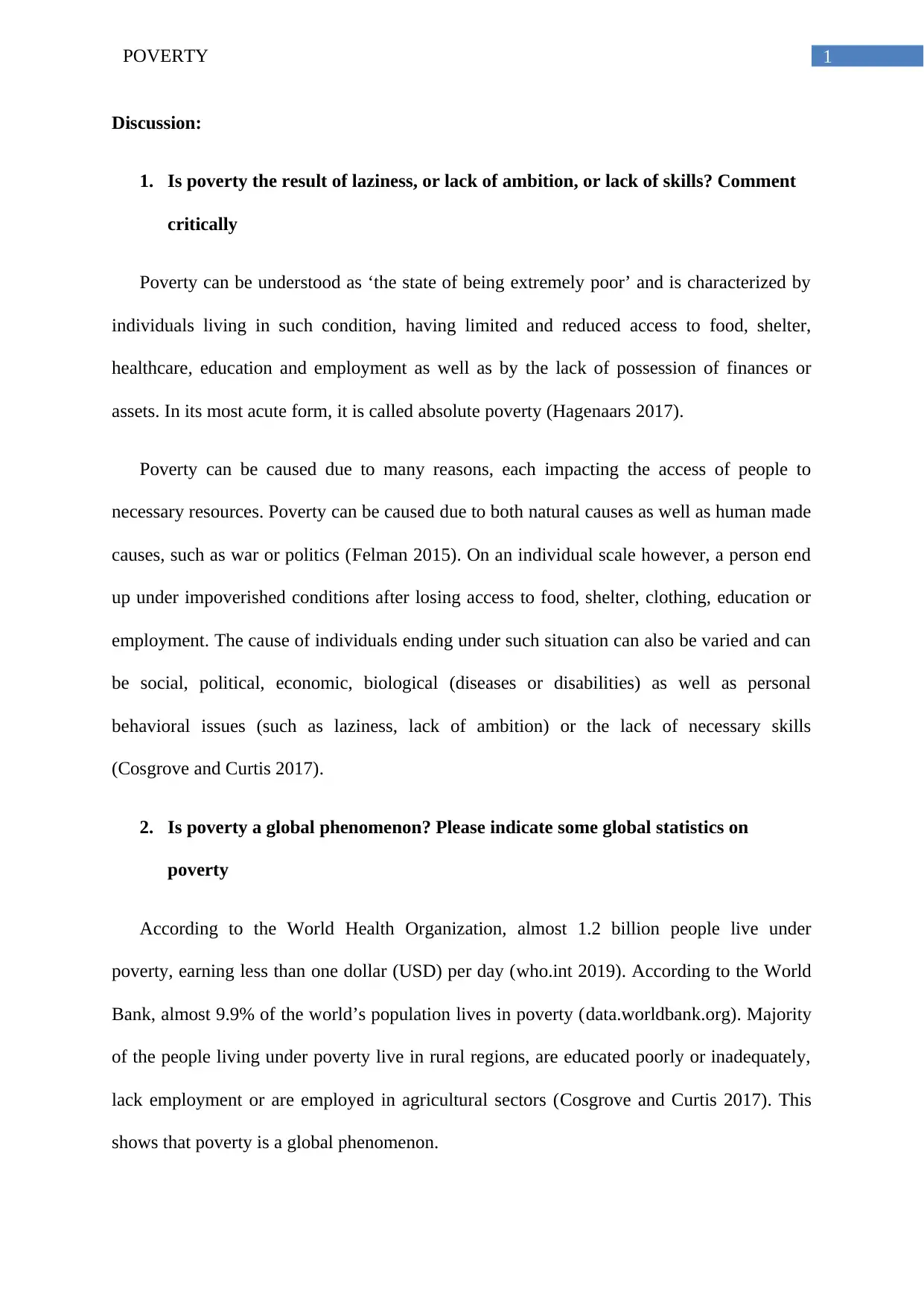
1POVERTY
Discussion:
1. Is poverty the result of laziness, or lack of ambition, or lack of skills? Comment
critically
Poverty can be understood as ‘the state of being extremely poor’ and is characterized by
individuals living in such condition, having limited and reduced access to food, shelter,
healthcare, education and employment as well as by the lack of possession of finances or
assets. In its most acute form, it is called absolute poverty (Hagenaars 2017).
Poverty can be caused due to many reasons, each impacting the access of people to
necessary resources. Poverty can be caused due to both natural causes as well as human made
causes, such as war or politics (Felman 2015). On an individual scale however, a person end
up under impoverished conditions after losing access to food, shelter, clothing, education or
employment. The cause of individuals ending under such situation can also be varied and can
be social, political, economic, biological (diseases or disabilities) as well as personal
behavioral issues (such as laziness, lack of ambition) or the lack of necessary skills
(Cosgrove and Curtis 2017).
2. Is poverty a global phenomenon? Please indicate some global statistics on
poverty
According to the World Health Organization, almost 1.2 billion people live under
poverty, earning less than one dollar (USD) per day (who.int 2019). According to the World
Bank, almost 9.9% of the world’s population lives in poverty (data.worldbank.org). Majority
of the people living under poverty live in rural regions, are educated poorly or inadequately,
lack employment or are employed in agricultural sectors (Cosgrove and Curtis 2017). This
shows that poverty is a global phenomenon.
Discussion:
1. Is poverty the result of laziness, or lack of ambition, or lack of skills? Comment
critically
Poverty can be understood as ‘the state of being extremely poor’ and is characterized by
individuals living in such condition, having limited and reduced access to food, shelter,
healthcare, education and employment as well as by the lack of possession of finances or
assets. In its most acute form, it is called absolute poverty (Hagenaars 2017).
Poverty can be caused due to many reasons, each impacting the access of people to
necessary resources. Poverty can be caused due to both natural causes as well as human made
causes, such as war or politics (Felman 2015). On an individual scale however, a person end
up under impoverished conditions after losing access to food, shelter, clothing, education or
employment. The cause of individuals ending under such situation can also be varied and can
be social, political, economic, biological (diseases or disabilities) as well as personal
behavioral issues (such as laziness, lack of ambition) or the lack of necessary skills
(Cosgrove and Curtis 2017).
2. Is poverty a global phenomenon? Please indicate some global statistics on
poverty
According to the World Health Organization, almost 1.2 billion people live under
poverty, earning less than one dollar (USD) per day (who.int 2019). According to the World
Bank, almost 9.9% of the world’s population lives in poverty (data.worldbank.org). Majority
of the people living under poverty live in rural regions, are educated poorly or inadequately,
lack employment or are employed in agricultural sectors (Cosgrove and Curtis 2017). This
shows that poverty is a global phenomenon.
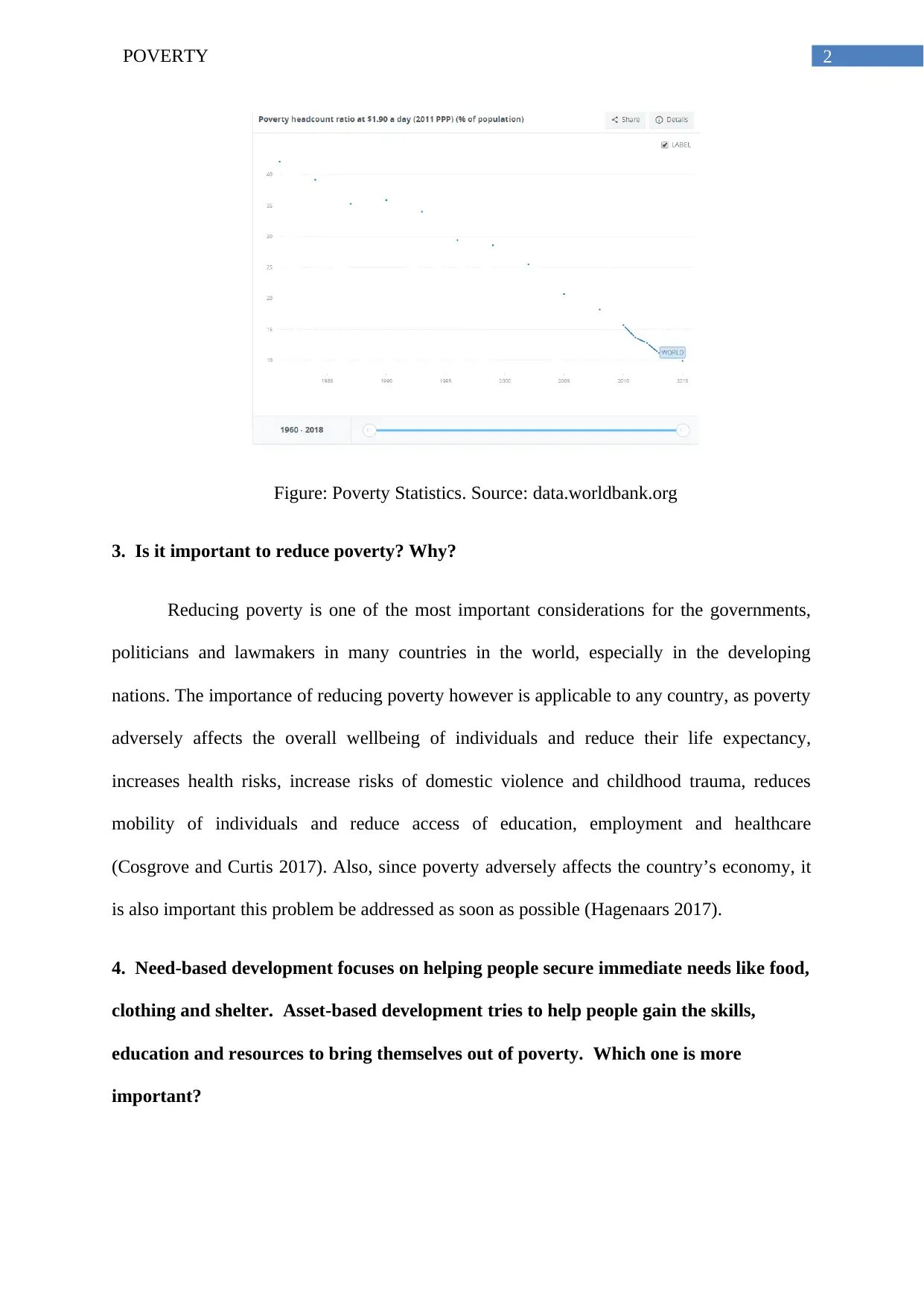
2POVERTY
Figure: Poverty Statistics. Source: data.worldbank.org
3. Is it important to reduce poverty? Why?
Reducing poverty is one of the most important considerations for the governments,
politicians and lawmakers in many countries in the world, especially in the developing
nations. The importance of reducing poverty however is applicable to any country, as poverty
adversely affects the overall wellbeing of individuals and reduce their life expectancy,
increases health risks, increase risks of domestic violence and childhood trauma, reduces
mobility of individuals and reduce access of education, employment and healthcare
(Cosgrove and Curtis 2017). Also, since poverty adversely affects the country’s economy, it
is also important this problem be addressed as soon as possible (Hagenaars 2017).
4. Need-based development focuses on helping people secure immediate needs like food,
clothing and shelter. Asset-based development tries to help people gain the skills,
education and resources to bring themselves out of poverty. Which one is more
important?
Figure: Poverty Statistics. Source: data.worldbank.org
3. Is it important to reduce poverty? Why?
Reducing poverty is one of the most important considerations for the governments,
politicians and lawmakers in many countries in the world, especially in the developing
nations. The importance of reducing poverty however is applicable to any country, as poverty
adversely affects the overall wellbeing of individuals and reduce their life expectancy,
increases health risks, increase risks of domestic violence and childhood trauma, reduces
mobility of individuals and reduce access of education, employment and healthcare
(Cosgrove and Curtis 2017). Also, since poverty adversely affects the country’s economy, it
is also important this problem be addressed as soon as possible (Hagenaars 2017).
4. Need-based development focuses on helping people secure immediate needs like food,
clothing and shelter. Asset-based development tries to help people gain the skills,
education and resources to bring themselves out of poverty. Which one is more
important?
⊘ This is a preview!⊘
Do you want full access?
Subscribe today to unlock all pages.

Trusted by 1+ million students worldwide
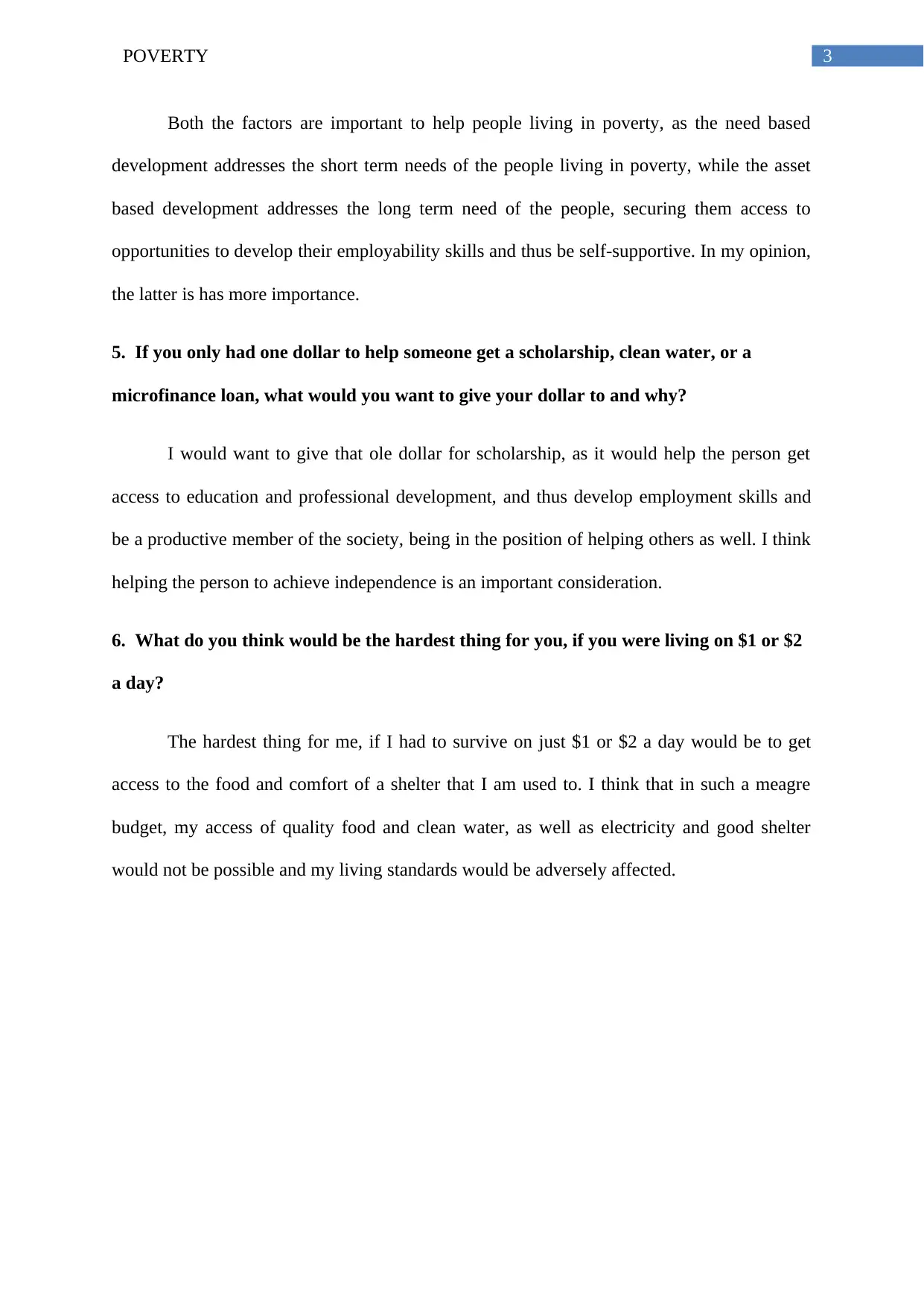
3POVERTY
Both the factors are important to help people living in poverty, as the need based
development addresses the short term needs of the people living in poverty, while the asset
based development addresses the long term need of the people, securing them access to
opportunities to develop their employability skills and thus be self-supportive. In my opinion,
the latter is has more importance.
5. If you only had one dollar to help someone get a scholarship, clean water, or a
microfinance loan, what would you want to give your dollar to and why?
I would want to give that ole dollar for scholarship, as it would help the person get
access to education and professional development, and thus develop employment skills and
be a productive member of the society, being in the position of helping others as well. I think
helping the person to achieve independence is an important consideration.
6. What do you think would be the hardest thing for you, if you were living on $1 or $2
a day?
The hardest thing for me, if I had to survive on just $1 or $2 a day would be to get
access to the food and comfort of a shelter that I am used to. I think that in such a meagre
budget, my access of quality food and clean water, as well as electricity and good shelter
would not be possible and my living standards would be adversely affected.
Both the factors are important to help people living in poverty, as the need based
development addresses the short term needs of the people living in poverty, while the asset
based development addresses the long term need of the people, securing them access to
opportunities to develop their employability skills and thus be self-supportive. In my opinion,
the latter is has more importance.
5. If you only had one dollar to help someone get a scholarship, clean water, or a
microfinance loan, what would you want to give your dollar to and why?
I would want to give that ole dollar for scholarship, as it would help the person get
access to education and professional development, and thus develop employment skills and
be a productive member of the society, being in the position of helping others as well. I think
helping the person to achieve independence is an important consideration.
6. What do you think would be the hardest thing for you, if you were living on $1 or $2
a day?
The hardest thing for me, if I had to survive on just $1 or $2 a day would be to get
access to the food and comfort of a shelter that I am used to. I think that in such a meagre
budget, my access of quality food and clean water, as well as electricity and good shelter
would not be possible and my living standards would be adversely affected.
Paraphrase This Document
Need a fresh take? Get an instant paraphrase of this document with our AI Paraphraser
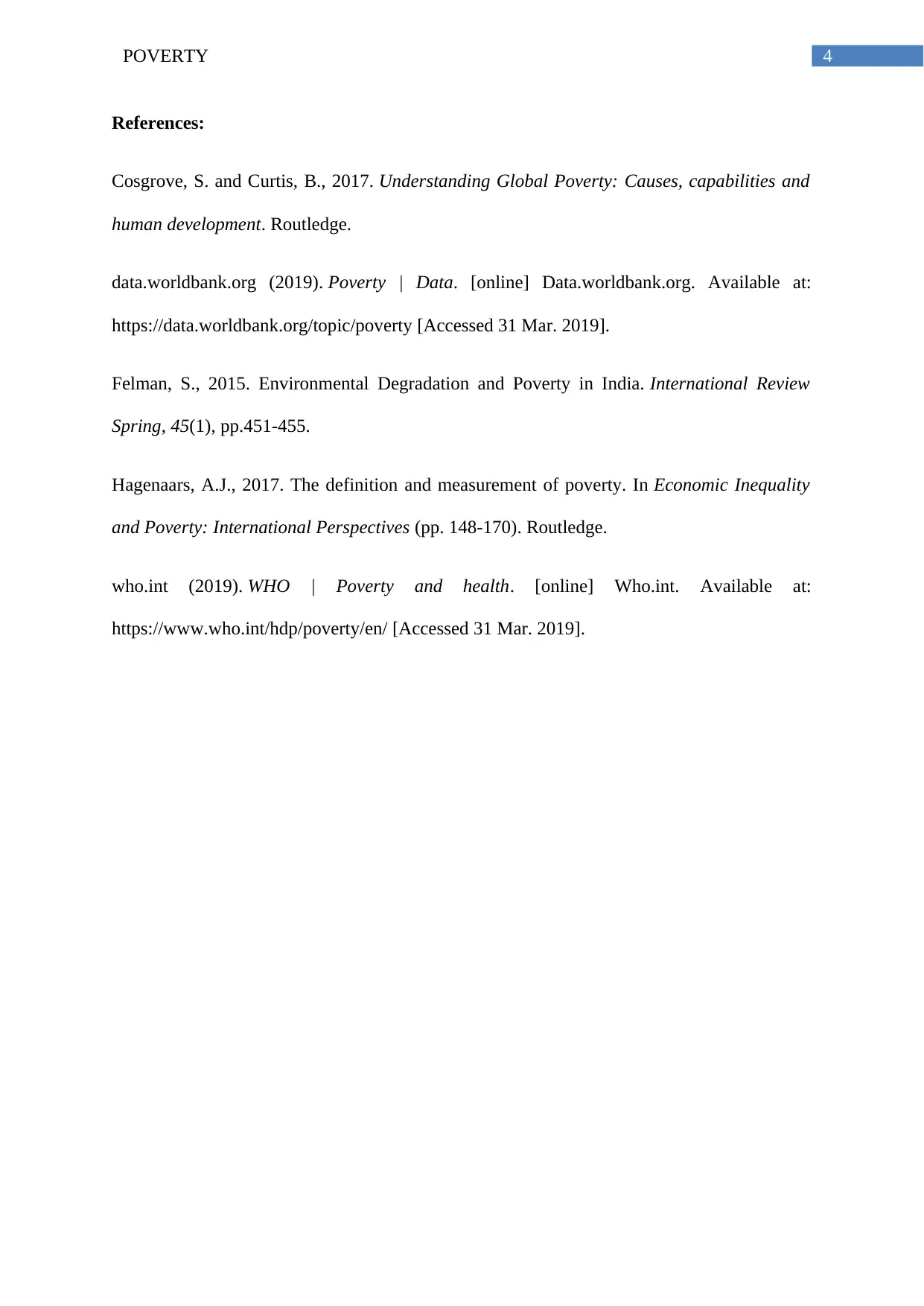
4POVERTY
References:
Cosgrove, S. and Curtis, B., 2017. Understanding Global Poverty: Causes, capabilities and
human development. Routledge.
data.worldbank.org (2019). Poverty | Data. [online] Data.worldbank.org. Available at:
https://data.worldbank.org/topic/poverty [Accessed 31 Mar. 2019].
Felman, S., 2015. Environmental Degradation and Poverty in India. International Review
Spring, 45(1), pp.451-455.
Hagenaars, A.J., 2017. The definition and measurement of poverty. In Economic Inequality
and Poverty: International Perspectives (pp. 148-170). Routledge.
who.int (2019). WHO | Poverty and health. [online] Who.int. Available at:
https://www.who.int/hdp/poverty/en/ [Accessed 31 Mar. 2019].
References:
Cosgrove, S. and Curtis, B., 2017. Understanding Global Poverty: Causes, capabilities and
human development. Routledge.
data.worldbank.org (2019). Poverty | Data. [online] Data.worldbank.org. Available at:
https://data.worldbank.org/topic/poverty [Accessed 31 Mar. 2019].
Felman, S., 2015. Environmental Degradation and Poverty in India. International Review
Spring, 45(1), pp.451-455.
Hagenaars, A.J., 2017. The definition and measurement of poverty. In Economic Inequality
and Poverty: International Perspectives (pp. 148-170). Routledge.
who.int (2019). WHO | Poverty and health. [online] Who.int. Available at:
https://www.who.int/hdp/poverty/en/ [Accessed 31 Mar. 2019].
1 out of 5
Related Documents
Your All-in-One AI-Powered Toolkit for Academic Success.
+13062052269
info@desklib.com
Available 24*7 on WhatsApp / Email
![[object Object]](/_next/static/media/star-bottom.7253800d.svg)
Unlock your academic potential
Copyright © 2020–2025 A2Z Services. All Rights Reserved. Developed and managed by ZUCOL.





